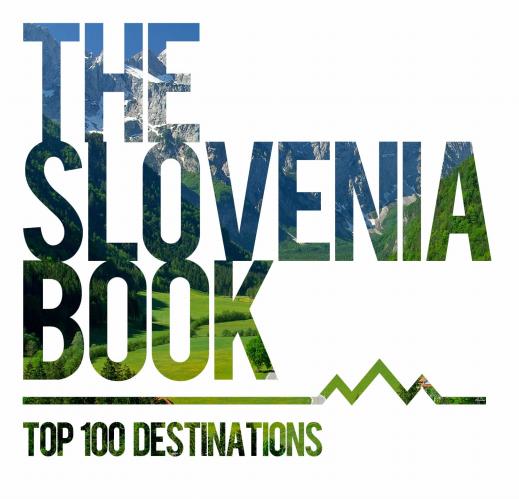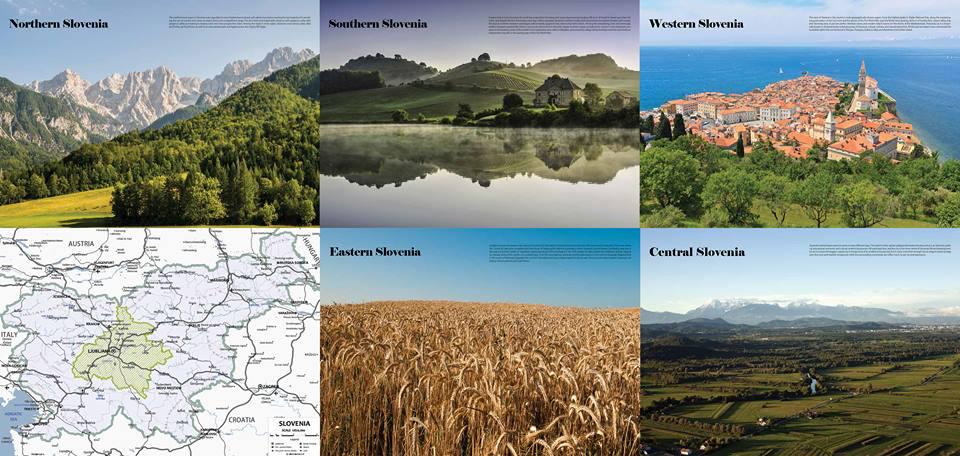

Yuri Barron from the US, John Bills and Will Dunn from the UK, and James Cosier from Australia, have all lived in Slovenia for several years. Over the seven-year period, they visited, photographed and selected their 100 favourite places in Slovenia. The result is The Slovenia Book – Top 100 destinations.
Besides these 100 top destinations, the book is enriched by interviews with Slovene celebrities, top 10 lists, descriptions of over 1,000 tourist attractions, photographs and up-to-date practical information. The book lists numerous interesting spots in Slovenia and describes the best ways to reach them. It also lists the ten greatest attractions, the ten most typical dishes, the ten best known castles and ten skiing destinations.
Love. Work. Family roots. These are but a few of the things connecting the four English-speaking journalists to Slovenia. They wrote the guide in the hope that their seven-year observations will help tourists who want to explore Slovenia’s towns and countryside with a slightly different guidebook.
Overlooked attractions
"I first came into Slovenia while travelling. I fell in love with the country immediately; a year later, when I returned, I fell in love with my girlfriend and stayed. It’s been six years since," explains Will Dunn in fluent Slovene. Since he chose Slovenia to be his new home, he has viewed the local life and people differently than when he was still a tourist.
Yuri Barron, who was also the managing editor of the book, agrees: "Foreigners’ view of Slovenia is different than that of Slovenes. When, for example, I visited Krško and talked with the locals, nobody suggested that I should see the nuclear plant. But this was what I found most interesting, as the plant was my first thought related to Krško. And tourists can actually visit it. Or the Kranj underground tunnels. A bomb shelter can be very informative for someone who cannot see World War II-related history at home, but hardly any locals recommended it," he comments in explanation of what kind of sights and attractions were sought out and found their place in the book. The souvenir list thus includes the well-known beehive panels, Idrija lace and Piran salt, as well as slippers made of Solčava wool and decorative and practical forged iron products from Kropa.
And what impressed them most about Slovenia? "It may sound a bit of a cliché, but it really is the best of Europe in one small convenient package! Within an hour’s drive from the quaint and increasingly cosmopolitan capital of Ljubljana, you have the Mediterranean coast, the Alps, wine regions, countless cultural and historical sites, ski resorts, thermal spas and lots more," says Yuri. Although the differences between the USA and Slovenia are surprisingly small, he notes, "However, aside from the usual differences between the USA and Europe – such as progressive socialist policies like state-funded education and healthcare, workers’ rights, and high-quality infrastructure maintained by a sustainable tax scheme –, one of the more trivial things that still surprises me is the limited business hours, especially on Saturdays and Sundays. In US cities you can more or less buy anything you need 24 hours a day, while in Slovenia this is not so much the case."
Delighted by rural tourism
The authors say they really love visiting tourist farms, so-called open-door farms, ethnological museums and everything else that makes up rural tourism, or agritourism as it is usually known: "I think most Slovenes don’t really associate farms and rural culture with tourism, and many may even take it for granted since even those who live in urban areas often have grandparents or other relatives in the countryside whom they regularly visit. However, for many foreign visitors, especially those from the US, visiting the Slovene countryside is a truly unique and memorable experience – in no small part due to the friendliness of the people, as well as the food, drinks and overall atmosphere," Yuri enthuses.
The authors were particularly thrilled by Ljubljana, Bled, Portorož and Piran and several of the larger spa resorts. However, a growing number of niche areas (such as wine holidays, adrenaline sports, eco-friendly activities, casinos and the aforementioned rural tourism) will likely become increasingly important in the future, as Slovenia continues to differentiate itself from neighbouring countries. They were all extremely impressed by the Solčava region, as being a first among many equals, while attention is also given in the book to many amazing individual sites, such as the Božidar Jakac Gallery, the Eco-Museum of Hops in Žalec, Žiče Monastery, Lake Bohinj and the entire coast: "As for what I like the least, really one of the only bad things about being a tourist in Slovenia is the unpredictable weather, especially in recent years! Not knowing if it’s going to be rainy or sunny (or even snowing) from week to week can make it difficult to plan an itinerary in advance!"
Incredible natural beauty of the country
Another of the authors,James Cosier, shares his enthusiasm for Slovenia thus: "I think Slovenes have long known about and been very proud of the incredible natural beauty of their country, though apart from a few major attractions, foreigners weren’t ever really aware of just how much Slovenia has to offer. And it’s not just the spectacular and diverse natural wonders: there are also interesting historical and cultural sights almost everywhere you go. Thankfully the local tourism sector is definitely getting better at selling itself and showing visitors just how amazing Slovenia is – and hopefully the book will do that too. Coming from Australia, Slovenia’s size was one of the biggest shocks for me. Everything is a couple of hours drive away – you can ski in the morning and have dinner beside the Adriatic all in the same day. Also, I love experiencing Slovenia’s seasonal changes, especially all the excellent seasonal foods."
James was particularly enthralled by the River Kolpa: "It’s a prime example of one of the many amazingly beautiful sights in Slovenia which foreigners don’t even know exist, and there are countless other incredible attractions right across the country. Travelling around Slovenia, I love to see the incredible regional differences both geographically and culturally, not least in the delicious regional delicacies from Belokranjska pogača to Prekmurska gibanica. The most frustrating thing about travelling in Slovenia is the poor public transport network, which means a car is basically a must if you want to see even a fraction of what the country has to offer."
The third author of the guide,John Bills from Wales, described Slovenia as an aesthetically special country. What surprised him most was the large number of casinos, although he is not a visitor of those himself.
As pointed out by executive editor Niko Slavnič, the book would make an interesting present for foreigners and is a great guide for families looking for ideas for trips. As it is written in English, it could even be used to help children learning that language!
Over half of the 3,000 copies of the first edition have already been sold, and the authors hope the rest will soon be snapped up. "And a new project is already underway: The Ljubljana Book, a similar guide focusing on the capital, is expected to be published next year. The content is all already in, but there’s so much information that it does still need some sorting out," Niko notes.
Vesna Žarkovič, SINFO


































































